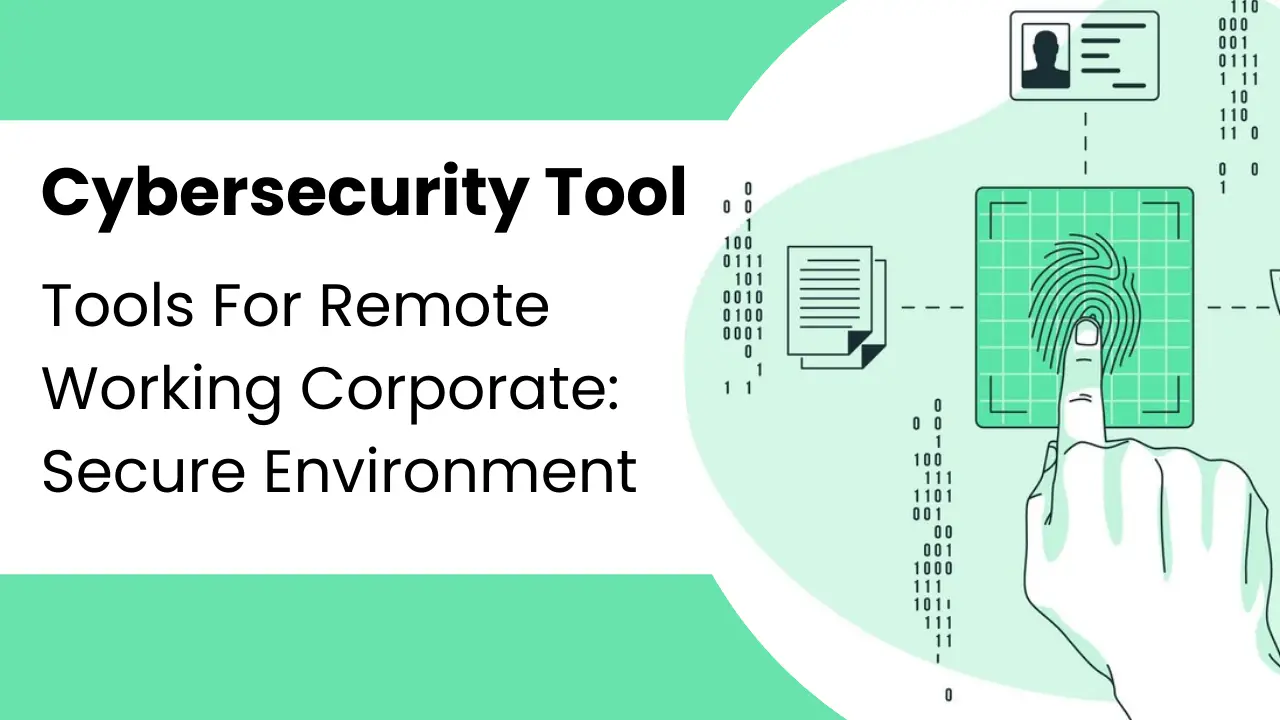Are you looking for cybersecurity tools for remote work?
As more employees stay remote, cyber security for remote employees has become essential. Working remotely brings new opportunities for organizations but if the organization has to deal with data confidentiality problems then welcome to the new opportunities. Home networks that remote employees work from offer far less security than formal office networks, which are something that cybercriminals will seize the opportunity to exploit.
Hackers access remote employees through their devices and enterprises without adequate protection and security. No matter for what purpose you are using a VPN be it for working remotely, accessing organizational data, or communicating with colleagues, it is crucial to keep remote work safe.
1. Establish Effective Virtual Private Network (VPN)
VPN for remote work is one of the most fundamental and powerful tools for how remote work security could be protected. Here’s how to maximize security with VPNs:
- Choose trusted VPN providers: Make sure your team utilizes credible and effective service providers that embrace NordVPN Teams, Cisco AnyConnect, or Perimeter 81. All these services deliver high-level encryption and other security enhancements that fit teams working remotely.
- Enforce VPN use at all times: Employees should always sync to their workplace VPN every time they wish to access a company file from the network from any network other than the workplace because the security could be wanting.
- Monitor VPN usage: The second and last recommendation concerns frequent monitoring of VPN logs in an attempt to detect any unauthorized attempts to gain access to the system; reinforcing the protection by using two-factor or multi-factor authentication.
2. Implement different factor authentication (DFA)
Staying only on passwords makes organizations vulnerable to cyber threats, more so with the current work from home. MFA is one of the best solutions for IT system security for a remote team, and it is imperatively necessary to introduce it. MFA increases security by ensuring that at least two or more forms of identification are used before one is granted access to the company’s system.
- SMS codes: Users first type in a PIN number and after that, they get a one-use code on the phone in the form of an SMS.
- Authentication apps: Using services such as Google Authenticator or Authy, users receive pins that are used in conjunction with the password at a given time.
- Hardware tokens: Hardware tokens are created as a physical gadget that produces a time token code such as the YubiKeys.
MFA helps to guarantee the complete security of the accounts and vital company data, even if the password is exposed. This is especially important for preserving confidentiality where data protection especially for remote teams is of the essence.
Here are a few best practices for integrating MFA into your cybersecurity for remote workers strategy:
- Make MFA mandatory: In other words, MFA should be used by everyone Click to read more about Multi-factor Authentication at work, including those with low job demands.
- Train employees: Make sure that all participants on the team comprehend the aim and functionality of MFA and why the protection of remote work is important.
Combined with strong password policies: Although MFA is one step ahead of traditional password-based security, it becomes fully effective when paired with properly set passwords for each account.
3. Encrypt Sensitive Data
cyber security remote employees, cybersecurity working from home, remote it security
Data encryption is also instrumental to cybersecurity for individuals who work from home. Encryption is a technique of safeguarding information whether in storage or in transit across networks or devices. This is particularly true for remote workers because their files are normally stored and shared in the cloud and they work using several collaboration tools.
Best Practices for Encryption:
- End-to-end Encryption: End-to-end encryption should be enabled on communication tools including messaging apps or video conferencing apps and tools (Signal, WhatsApp, etc). This makes it possible for only the target audience to come across the content.
- Encrypt Files Before Sharing: When people share documents with other people who work in other locations, keep the files secure, preferably, encrypted. Dropbox Business and Google Drive have features and a menu that enable users to work with encrypted files to ensure that everyone can share sensitive data securely.
- Full Disk Encryption: Further, most workers put in use laptops and other devices with full disk encryption to enhance security for remote workers. Hence all the data stored on the device can be auto-encrypted using disk encryption software like BitLocker on Windows devices or File Vault on MAC OS devices.
Security especially for remote teams is made possible by components like encryption in the working process. It shields business information from falling into the wrong hands, whether hacked or pilfered off lost or stolen equipment.
4. Set Adequate Password Standards
A bad password is usually an open door through which hackers access an individual’s account. Despite the benefits that remote working has brought to organizations, cybersecurity for such workers requires standard approval of passwords that safeguard the company’s data and IT systems. Those who work from home but still use their office systems in remote environments on different devices are at risk as soon as one or several passwords are grouped.
Key Elements of a Strong Password Policy:
- Use Unique Passwords for Every Account: Explain to employees that they have to use different passwords while working on different platforms and systems. Using the same password for several accounts is dangerous because hackers become more likely to steal the passwords.
- Adopt a Password Manager: An application such as LastPass or Dashlane, means that remote employees can safely store and create complex and unique passwords. This means that the users are not overwhelmed with different passwords to remember while, at the same time, they will be complex to guess.
- Enforce Regular Password Updates: Ask remote employees to change their passwords regularly, for example, every 60-90 days. It decreases the probability of long-term exposure if a password is hacked, in addition to frequency.
- Use Passphrases: Rather than short and haphazard sequences, suggest that your employees opt for longer passphrases – sequences of words or entire sentences, which are more difficult to crack but much easier to recall. For example – “PurpleTreesDanceInWind!”
- Enable Multi-Factor Authentication (MFA): Support plain and complex passwords with multi-factor authentication as this measure will reduce the incidence of unauthorized access.
5. Secure Endpoint Devices
A prominent area of focus that hackers exploit when targeting remote employees is the endpoint device for instance laptops smartphones and tablets. These devices are largely out of the corporation’s IT department’s control and, therefore, attractive to hackers. The protection of these devices is very important to the security of working remotely and to the safety of the IT systems.
How to Secure Endpoint Devices:
- Install Antivirus and Anti-Malware Software: Make sure each remote employee’s computer is protected by a credible antispyware/antivirus solution (such as Bitdefender Total Security, Norton 360). These tools are able to identify and prevent any malware that may be potentially damaging to the system.
- Enable Firewalls: Firewalls help to prevent dangers from the internet from accessing the device. Employees must be advised to have the built-in firewalls active in an attempt to lower the occurrences of unauthorized access to the companies’ information and data.
- Keep Devices Updated: It’s also important to avoid using old software and operating systems that contain noticeable security risks. Remote workers need to make sure their tools of working are updated to the latest security releases. The automatic updates should be on whenever there is that possibility.
- Use Encryption for Data Protection: Full disk encryption should be enabled in endpoint devices. Others such as FileVault for OS X and BitLocker for Windows encrypt the entire hard drive making it impossible to get to the information if the gadget gets lost or taken.
- Secure Remote Access with VPN: To connect to the company’s systems, using a VPN for remote work increases security measures as the connection between the device and the company will be secure.
- Monitor Device Security with Endpoint Protection Tools: tools like the CrowdStrike Falcon or Sentinel One can watch endpoints and if any kind of malicious action is detected on an employee’s device, the tool will inform IT in real-time.
Conclusion
end-point security, protection against phishing, safe file transfer, cybersecurity rules for distributed teams, and cybersecurity for remote workers. Cybersecurity for remote workers is achieved in layers and it involves the use of technology solutions, business policies, and good practices. With working from home more pronounced than it has been in the past, that means that cyber threats to remote teams are becoming more frequent as well. That is why most companies should implement solutions like VPN for remote work, MFA, endpoint security, encryption, etc, to protect such information.
Awareness starts with teaching employees about the dangers, for example, phishing, and having proper cyber security protocols to direct employees who work remotely daily. Other measures include making regular backups, only using safe methods to share files, and monitoring systems to ensure that IT system security is high even in a scenario where work from home is being practiced.
FAQs About cybersecurity tools for remote work
1. Which cybersecurity tools are crucial for employees who work remotely?
The absolute bare minimum for cybersecurity for remote workers consists of a Virtual Private Network for remote working that secures links to the data, and multi-factor authentication for logging in to the system. Furthermore, basic endpoint protection such as antivirus and firewalls should also be considered for installation on all devices.
2. VPN used in cybersecurity: how remote workers are safeguarded from risks?
Remote work VPN protects Internet connection ensuring that the worker’s data is safe by establishing a secure connection between the worker and the company’s network. This enables securing of data transmitted over there unauthenticated internet connections thereby facilitating the secure remote working of the company systems.
3. What makes multi-factor authentication important when users work remotely?
Multi-factor authentication (MFA) means that before the employee has access to resources, the employee will have to prove identity using many more methods like password plus code. This makes it so much harder for hackers to break into IT systems, even if they do secure a password.
4. What information should be included in a remote work cybersecurity policy?
The cybersecurity policy of remote working should include regulation on proximal access, passwords, security for remote users, file sharing among teams, and precautions against phishing scams. It should also lay down how the organization uses encryption and other non-optional apparatuses, such as VPNs and MFA.
5. What opportunities, measures, and risks remote work have brought about in terms of avoiding phishing attacks?
To guard against phishing attacks, employees should be taught how to identify a phishing email, not to click on the link attached to the email, and to use an anti-phishing tool. Phishing protection must be trained frequently to keep the employees active against possible threats.

